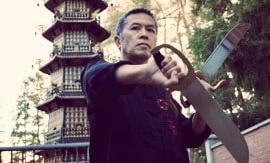
THE SIX HARMONIES IS A TERM OFTEN USED TO DESCRIBE THE UNIFICATION OF MIND AND BODY IN A NUMBER OF WELL-KNOWN CHINESE MARTIAL ARTS, INCLUDING MANTIS, BAGUA, XING YI QUAN, TAI CHI, AND SHAOLIN (OF COURSE). THE HARMONIES ARE DIVIDED INTO TWO SEPARATE CATEGORIES, THE INTERNAL AND THE EXTERNAL, AND BOTH ARE APPLIED COMMONLY IN WING CHUN.
The harmonies guide how the body should move, expand, and contract in order to generate the maximum amount of power with minimum effort, and they also guide how the energy is to be managed within any focused activity. They show how to maintain a strong structure, or as some might call it: mechanical integrity. This full body mechanical integrity is required against stronger, much larger opponents—mainly because hand and arm techniques alone will not be powerful enough to withstand their offence.
The three external harmonies guide the three key pairs of body coordination and power generation; they include the hands, elbows, shoulders, hips, knees, and finally feet. The three internal harmonies govern and teach how to get the most from the mental game by managing Qi flow, intent, and the fighter’s spirit too.
Imagine if there was a formula created that shows how to get the most from each encounter—whether you were in a fight or perhaps just doing your daily training. With this formula, you have the recipe for how to develop the highest calibre Gung Fu. The gotcha with this recipe is that, similar to many other high-level skills, it takes a lot of time and attention to detail to develop. Many people, therefore, do not realise the benefits, so they simply neglect these valuable suggestions.
There are many pages that are dedicated to the six harmonies in ancient Gung Fu texts. These texts talk about how the hands coordinate with the feet, how the elbows coordinate with the knees, and how the hips coordinate with the shoulders. This coordination can be both along a vertical or horizontal plane, meaning if a knee moves outward the elbow is likely to as well. If the knee moves forward, the elbow is directed to do the same according to these guidelines. Also, the coordination applies cross body so if the right foot moves forward, it can be coordinated with the left hand too.
In Wing Chun, we hint that we apply these harmonies right from the beginning of the form. In the Siu Lim Tau form, we are taught to press the knees inward while many of the techniques in the form press inward with the elbows. Although the feet do not move in the form, the concept still exists in many of the subsequent movements.
In the Cham Kiu form, demonstrations of the three external harmonies are rampant as we step and practise coordinating constantly our hands with our feet. The shoulders stay aligned above the hips as the hands and feet move in complete unison. With the hip and shoulder unification, we will notice that, when turning, the entire body and torso move as one whole unit.
Often this physical coordination is generally referred to as timing. When the body does not move as one cohesive unit, it is uncoordinated, or when the fist lands before or after the step, this student who has poor harmony is often labelled as having bad timing as well. The harmonies are therefore the source of some classic martial tenets such as “the foot and the fist arrive together” and also “when one part moves, the whole body moves”.
To practise the three external harmonies, find a full-body mirror and practice any stepping drill of your choice. Starting slowly at first and speeding up as you get better coordination, take a step forward while keeping your wrist aligned with your ankle. Use the mirror to ensure that you maintain a straight vertical line between the foot and the wrist.
Once you can move your punch (or two-handed technique) at the same rate as the step, it’s time to speed up the drill. Try doing it a little faster or try moving in random directions. Each time you step, work on maintaining the timing so that the hands and feet move together and land at the same time, and that when one part of the body stops moving, all parts of the body stop moving with it.
When shifting, the same theories generally apply. Practise shifting right and left with a technique. Watch closely to make sure the technique stops in the right position at exactly the same time that the shift stops.
The three internal harmonies train us to maintain a state of unity between the mind and body, as well as maintaining a clear focus on the task at hand. The three internal harmonies involve the heart, the intention, the Qi and strength (muscle). The harmonies are described easily by saying that the heart (also known as the martial spirit, desire, emotional mind, or even will) leads the intention to take an action.
Heart harmonising with intention is the first of the three harmonies. Harmonising heart with intention has the tendency to focus the mind on the task that is at hand. Within this context, heart is often translated as the emotional mind and the intention is often translated as the intellectual mind. This subsequently opens the first harmonisation to the interpretation that both the emotional need for survival must be coordinated with an intellectual understanding of maintaining proper technique and strategy.
The wisdom mind must always act naturally, reactively and correctly when required—almost as if it’s second nature. This cannot be accomplished without a great deal of training first. This intent, therefore, can represent our commitment to training and also winning. It is our mental strength and focus—perhaps our willpower.
The second harmony links one’s intention with one’s Qi. Qi can be considered to be the body’s essential energy and to some people the essential energy of the universe and everything that’s inside it. The intention mobilises the Qi, guiding it through the body to energise and protect by gathering it, controlling it, and then eventually releasing it.
The final harmony is to connect the Qi with the physical body. The physical body is the final manifestation of heart, intention, and Qi. These harmonies all work together much like the external harmonies do, namely to create a single unified internal connection. This single entity is the foundation for the perfect mindset crucial to winning a confrontation. This final piece allows one to create maximum power with minimum effort.
Faat Jing is the ability to generate explosive energy into the opponent. In order to maximise your Faat Jing—to maximise its power and effectiveness, it is necessary to follow the harmonies, and that’s regardless of your martial art.
There are many valid methods of generating power when fighting. Application of the six harmonies is a recognised and time-tested method of generating the full amount of body power without using muscle tension.
I recommend training with these harmonies in mind and that you discover this valuable method of generating power.



















